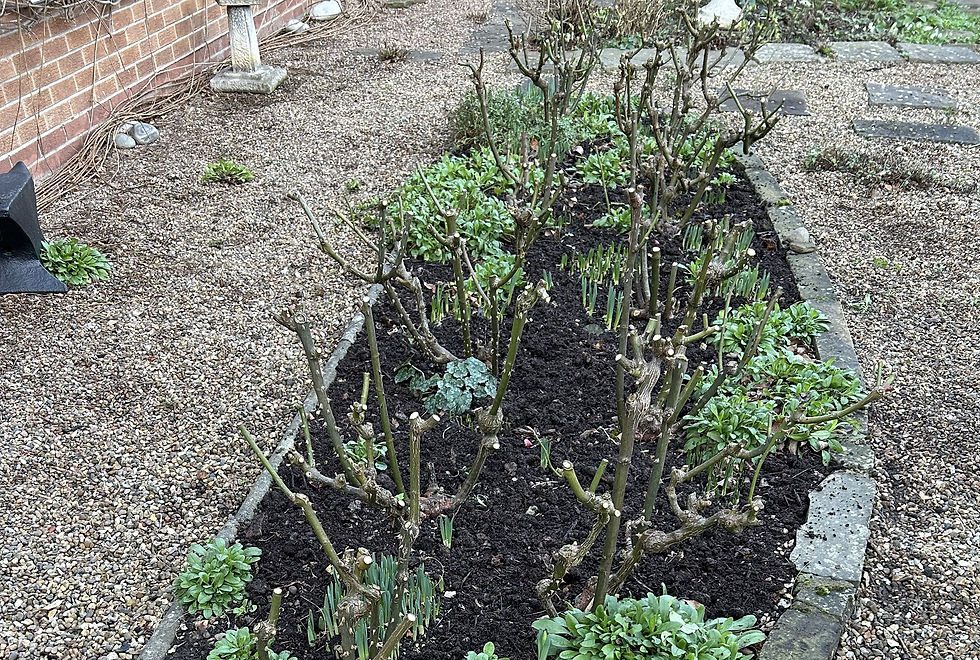Revitalise roses in February
- patrickwiltshire3
- Feb 10, 2024
- 4 min read
I love to give garden roses a little TLC in February, the off-season. You may think February’s a month where nothing's going on outside but there’s one or two things in the garden that warrant our attention. As an East Yorkshire gardener I'm onto them!

I diary the task of pruning roses every February for my customers (and my mum!) and, when the weather’s behaving, it’s actually one of my favourite jobs.
So why’s it good to prune roses in February?
The plants are dormant. While our roses are dormant from around December to March (or later if winter’s overstaying its welcome!) we're able to prune. The sap’s not rising in the stems so they’re not likely to ooze sap (bleed) out of the pruning cuts.
The plants have lost some if not all their leaves. When us gardeners are able to see the general framework of plants, we can make clear decisions on which stems we can prune with nice, sharp secateurs. Having a good look at the plants’ overall shape works very much in our favour. It’s good to be able to see where all the buds are facing along the stem too. As a horticulturist I’m mindful of cutting just above a bud so there’s less chance the branch will go brown and ‘die-back’.
Prickly thorns are in full view! When there are fewer leaves on the plant I’m able to see where all the thorns are. Good news. I’ve had my fair-share of splinters in my time as a gardener (even with gloves on!) so it’s good to see where my next thorny-threats are.
Pruning promotes healthy plants. I’ve found the worst thing for most rose types is to under prune (especially if you’re looking for lovely summer blooms decorating the whole of your plants). With pruning out too few stems or not pruning the stems from near enough to the ground you’ll get;
*Flowers tending to appear only at the tops of your plants
*Overcrowded stems that provide the perfect home for diseases like black spot
What am I pruning out on roses in the winter?

Roses grow healthily and flower prolifically for much of the year when the plants have an open shape and are well-ventilated. You're looking to achieve a nice air-flow through the plant and as little congestion in the centre of the plant as possible.
Why is air-flow important? So that diseases (like black spot) don’t thrive on your roses, spoiling both the look (and health) of your plants. Diseases enjoy damp, humid environments in the main, like in congested rose plant, which us gardeners want to avoid.
First of all I want to take away the dead stems off the plants. These tend to build up on rose plants after some time so it’s good to get rid of all the dead stems.
Secondly I’m on the look-out for stems growing towards the centre of the plant and cutting these stems out. How? By moving my sharp secateurs up from as low down the stem as I can see. I’m looking for the next bud up which is facing away from the centre of the plant. And then SNIP.
Once I spot the bud looking in the direction I want it to (alas, there’s not always one there! - in which case I prune it to ground level) I’ll snip the stem about ½-1cm above it. When the warmer weather arrives in spring, the bud just below the cut will burst into growth to produce a stem growing outwards.
Thirdly I want to locate strong, outside framework stems and prune them to the correct height.

How far down do I prune the rose stems that I want to keep?
Here’s a summary of how far back I prune rose stems in the winter
Hybrid-tea roses: framework stems back to 15-30cm above the ground
Floribunda, miniature roses, patio roses: framework stems back by half their length
Climbing roses: framework stems to the framework of wires- sideshoots back to around 5cm
Rambling roses: only type not to be pruned in February, but instead in June/July, after flowering. I like to prune these stems right back to the centre stem.
Any aftercare after we’ve pruned our roses?
Good question, and I say a confident yes. Give all your roses a nice treat after you’ve pruned them. No matter what the rose type is, it’ll appreciate a nice dose of mulch/compost/rotting leaves around the base of the plant.
I use home-made well-rotted compost (see image above) and cover the area under the plant with a 5-7cm thick layer, leaving clear the area immediately around the stem in the middle.
The reason to leave the centre-stem clear of mulch: The compost is high in nutrients so can risk damaging the plant trunk on contact. The surrounding area you’ve covered with compost though will;
a) give your roses a level of nutrients to replace food stored in the stems that have been pruned
b) protect the surface roots of your rose plant
c) give the soil a warming cover from the frost
d) give worms a fantastic supply of food to pull into the soil, improving the soil texture a treat
e) improve the beneficial fungal and bacterial ecosystems in the soil
If rain’s not due, water the area under your rose bed generously.

